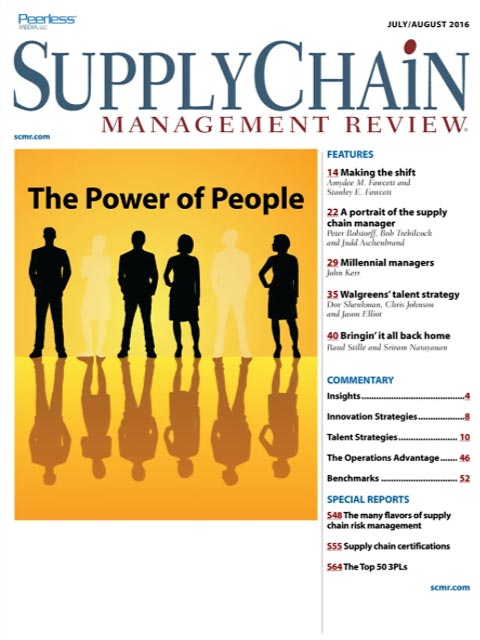Sorry, but your login has failed. Please recheck your login information and resubmit. If your subscription has expired, renew here.
July-August 2016
What’s the difference between us and our competitors? Our people!” I can’t think of an organization that doesn’t publicly state that its people are its most important asset. Yet, anyone who has been in the workforce for any length of time knows that when the rubber hits the road—or something else hits the fan—people are usually the first casualty of cost cutting. It’s far easier to free up your talent for “other opportunities” than it is to close a plant or sell a fleet of trucks. Browse this issue archive.Need Help? Contact customer service 847-559-7581 More options
It’s been written that a career in supply chain management can be like climbing a mountain. While there is often a map for the path forward in professions like accounting, medicine and the law, in supply chain management—as with mountaineering—there are any number of paths that can reach the summit.
Those were among the findings from a research series conducted for the Council of Supply Chain Management Professionals (CSCMP) and published in the July/August 2015 issue of SCMR, and reinforced by research conducted by McKinsey & Company and Kuhne Logistics University. The latter, for instance, found that while many supply chain management executives had experience in logistics, procurement and sales/marketing, “... a surprising number of supply chain executives are appointed without any previous exposure to SCM…in our sample, supply chain executives spent 88% of their previous career span outside the SCM function.”
Are those findings consistent with readers of Supply Chain Management Review and members of APICS Supply Chain Council? And, if so, who is today’s supply chain manager? And, how did he—or she—navigate to their position on the mountain? Did they start out in the supply chain going back to their college days, or, as in the McKinsey study, did they come into the profession from other parts of the organization? Moreover, what are their duties today and how do they see the job changing?
 |
This complete article is available to subscribers
only. Click on Log In Now at the top of this article for full access. Or, Start your PLUS+ subscription for instant access. |
SC
MR
Sorry, but your login has failed. Please recheck your login information and resubmit. If your subscription has expired, renew here.
July-August 2016
What’s the difference between us and our competitors? Our people!” I can’t think of an organization that doesn’t publicly state that its people are its most important asset. Yet, anyone who has been in the… Browse this issue archive. Access your online digital edition. Download a PDF file of the July-August 2016 issue.
 |
Download Article PDF |
It's been written that a career in supply chain management can be like climbing a mountain. While there is often a map for the path forward in professions like accounting, medicine and the law, in supply chain management—as with mountaineering—there are any number of paths that can reach the summit.
Those were among the findings from a research series conducted for the Council of Supply Chain Management Professionals (CSCMP) and published in the July/August 2015 issue of SCMR, and reinforced by research conducted by McKinsey & Company and Kuhne Logistics University. The latter, for instance, found that while many supply chain management executives had experience in logistics, procurement and sales/marketing, “... a surprising number of supply chain executives are appointed without any previous exposure to SCM…in our sample, supply chain executives spent 88% of their previous career span outside the SCM function.”
Are those findings consistent with readers of Supply Chain Management Review and members of APICS Supply Chain Council? And, if so, who is today's supply chain manager? And, how did he—or she—navigate to their position on the mountain? Did they start out in the supply chain going back to their college days, or, as in the McKinsey study, did they come into the profession from other parts of the organization? Moreover, what are their duties today and how do they see the job changing?
 |
SUBSCRIBERS: Click here to download PDF of the full article. |
SC
MR

Latest Supply Chain News
Latest Podcast

 Explore
Explore
Topics
Latest Supply Chain News
- Strengthening customer fulfillment: Building a strategic stakeholder network
- The hard job of teaching soft skills
- Trump picks former Wisconsin congressman Sean Duffy for DOT secretary
- Made in Mexico, manufactured by China
- Retail sales see gains in October, reports Commerce and NRF
- Balancing green and speed: Home delivery insights from the pandemic era
- More latest news
Latest Resources

Subscribe

Supply Chain Management Review delivers the best industry content.

Editors’ Picks





